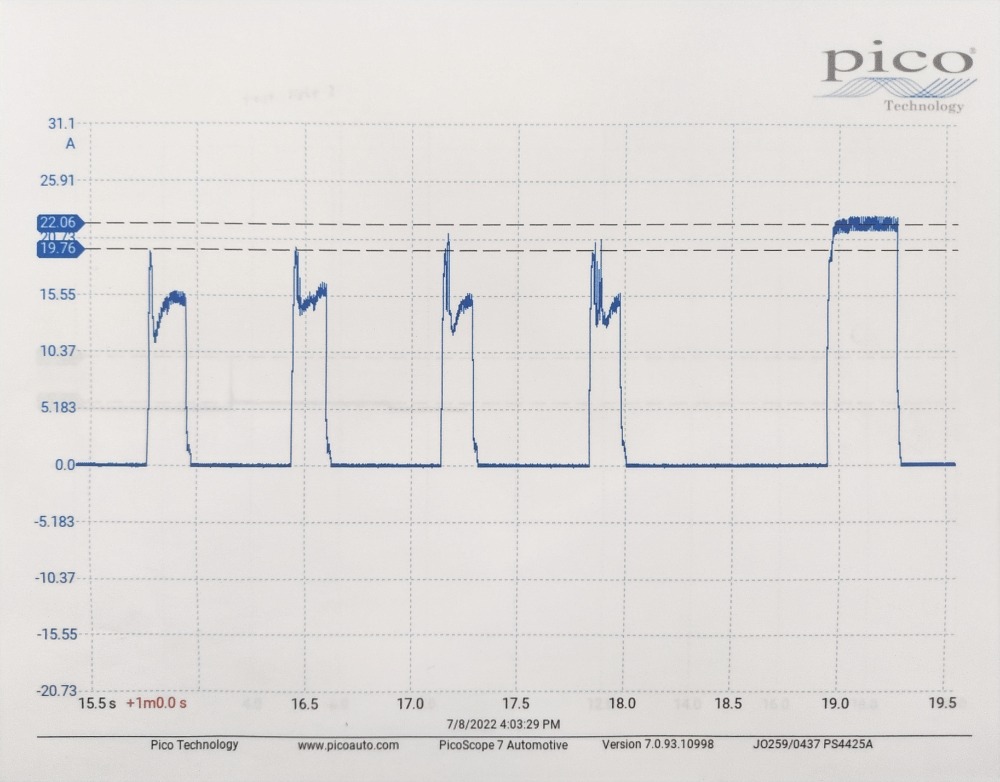*** Restricting New Posts to SD Premium Members ONLY *** (09 May 2025)
Just made a new account? Can't post? Click above.
Help us help you. By posting the year, make, model and engine near the beginning of your help request, followed by the symptoms (no start, high idle, misfire etc.) Along with any prevalent Diagnostic Trouble Codes, aka DTCs, other forum members will be able to help you get to a solution more quickly and easily!
2015 Honda Accord 2.4L M/T, intermittent no crank
- kirtland69
-
Topic Author
- Offline
- New Member
-

Less
More
- Posts: 3
- Thank you received: 0
3 years 3 months ago #56965
by kirtland69
2015 Honda Accord 2.4L M/T, intermittent no crank was created by kirtland69
Hello all. Long time lurker, first time poster.
This vehicle started as a typical starter replacement. Check for power on the starter trigger lead, voltage drop the heavy lead, replace the starter and done. And then it turned into a comeback for the same issue.
This issue only seems to present after multiple tries of the key, and even then it will still come and go. I attached a test light to the trigger lead (light draws 18 amps on inrush and 2.5 amps constant), and attached my scope to the heavy lead to monitor voltage drop. Test yielded the same result. Bad starter. Okay, lots of problems with crap parts these days, must have got a bad one. Replace the starter. Still have the same problem. WTF? Repeat the same tests. Same result. Realized I didn't check terminal tension. This particular starter doesn't use a ring terminal for the trigger, it's an actual connector. Was able to remove the plastic connector housing and inspect the terminal. Did a test fit on the starter and it seems ok, but pressed the terminal in to tighten it up anyway, reassembled the connector and plugged it back in. Tested and still have the same issue. Now I'm really stumped. Every time the starter fails to engage, the test light is on and bright, so the damn thing should be working.
Boss has the idea to monitor the current on the trigger lead, on the theory that maybe the relay is started to develop a burned contact and passing enough to light the test light but not enough to fire off the starter. I switch to a smaller test light (a little over 1 amp on inrush and .5 amp constant) for a smaller effect on the reading, attached the amp clamp, and ran the test. The result is shown in the attached waveform. I expected to see a degrading current draw when the starter failed to engage, but the actual result was the opposite. You can see in the waveform the expected inrush, a drop and slow increase as the starter engages. The single higher peak is when the problem presented and I'm at a loss as to what would be causing this result. Any ideas?
Added details:
There is no PCM involvement in this starter circuit
Entire circuit is fed by a 50 amp fuse
There is no stand-alone starter relay. It's built into the 'relay circuit board'
This vehicle started as a typical starter replacement. Check for power on the starter trigger lead, voltage drop the heavy lead, replace the starter and done. And then it turned into a comeback for the same issue.
This issue only seems to present after multiple tries of the key, and even then it will still come and go. I attached a test light to the trigger lead (light draws 18 amps on inrush and 2.5 amps constant), and attached my scope to the heavy lead to monitor voltage drop. Test yielded the same result. Bad starter. Okay, lots of problems with crap parts these days, must have got a bad one. Replace the starter. Still have the same problem. WTF? Repeat the same tests. Same result. Realized I didn't check terminal tension. This particular starter doesn't use a ring terminal for the trigger, it's an actual connector. Was able to remove the plastic connector housing and inspect the terminal. Did a test fit on the starter and it seems ok, but pressed the terminal in to tighten it up anyway, reassembled the connector and plugged it back in. Tested and still have the same issue. Now I'm really stumped. Every time the starter fails to engage, the test light is on and bright, so the damn thing should be working.
Boss has the idea to monitor the current on the trigger lead, on the theory that maybe the relay is started to develop a burned contact and passing enough to light the test light but not enough to fire off the starter. I switch to a smaller test light (a little over 1 amp on inrush and .5 amp constant) for a smaller effect on the reading, attached the amp clamp, and ran the test. The result is shown in the attached waveform. I expected to see a degrading current draw when the starter failed to engage, but the actual result was the opposite. You can see in the waveform the expected inrush, a drop and slow increase as the starter engages. The single higher peak is when the problem presented and I'm at a loss as to what would be causing this result. Any ideas?
Added details:
There is no PCM involvement in this starter circuit
Entire circuit is fed by a 50 amp fuse
There is no stand-alone starter relay. It's built into the 'relay circuit board'
Please Log in or Create an account to join the conversation.
- Cheryl
-
- Offline
- Platinum Member
-

Less
More
- Posts: 1214
- Thank you received: 215
3 years 3 months ago #56967
by Cheryl
Replied by Cheryl on topic 2015 Honda Accord 2.4L M/T, intermittent no crank
Have you voltage dropped the block ground? Go from battery negative post to engine block see if you have anything over 200 millivolts
Please Log in or Create an account to join the conversation.
- juergen.scholl
-

- Offline
- Platinum Member
-

- Active partschanger
Less
More
- Posts: 1230
- Thank you received: 462
3 years 3 months ago #56974
by juergen.scholl
An expert is someone who knows each time more on each time less, until he finally knows absolutely everything about absolutely nothing.
Replied by juergen.scholl on topic 2015 Honda Accord 2.4L M/T, intermittent no crank
The starter solenoid features two seperate windings, the pull-in and the hold-in. When turning the key to the start position both circuits are completed. The pull in windungs are grounded through the starter´s main windings and once the solenoid contact closes these pull-in windings receive 12V from both sides and the circuit deactivates. Only the hold-in cicuit stays energized. As result the curent through the wire activating the solenoid (terminal 50) is reduced.
Your scope capture does not show this reduction in current to the solenoid in the moment the starter fails. This suggests that the main contact does not close.
You may want to do voltage drop testing both positive and negative sides, maybe while bending wiggling the cables.As the solenoid keeps pulling close to 20A when the starter fails it is not a contact/pin fit issue on the solenoid wire
Your scope capture does not show this reduction in current to the solenoid in the moment the starter fails. This suggests that the main contact does not close.
You may want to do voltage drop testing both positive and negative sides, maybe while bending wiggling the cables.As the solenoid keeps pulling close to 20A when the starter fails it is not a contact/pin fit issue on the solenoid wire
An expert is someone who knows each time more on each time less, until he finally knows absolutely everything about absolutely nothing.
Please Log in or Create an account to join the conversation.
Time to create page: 0.294 seconds

